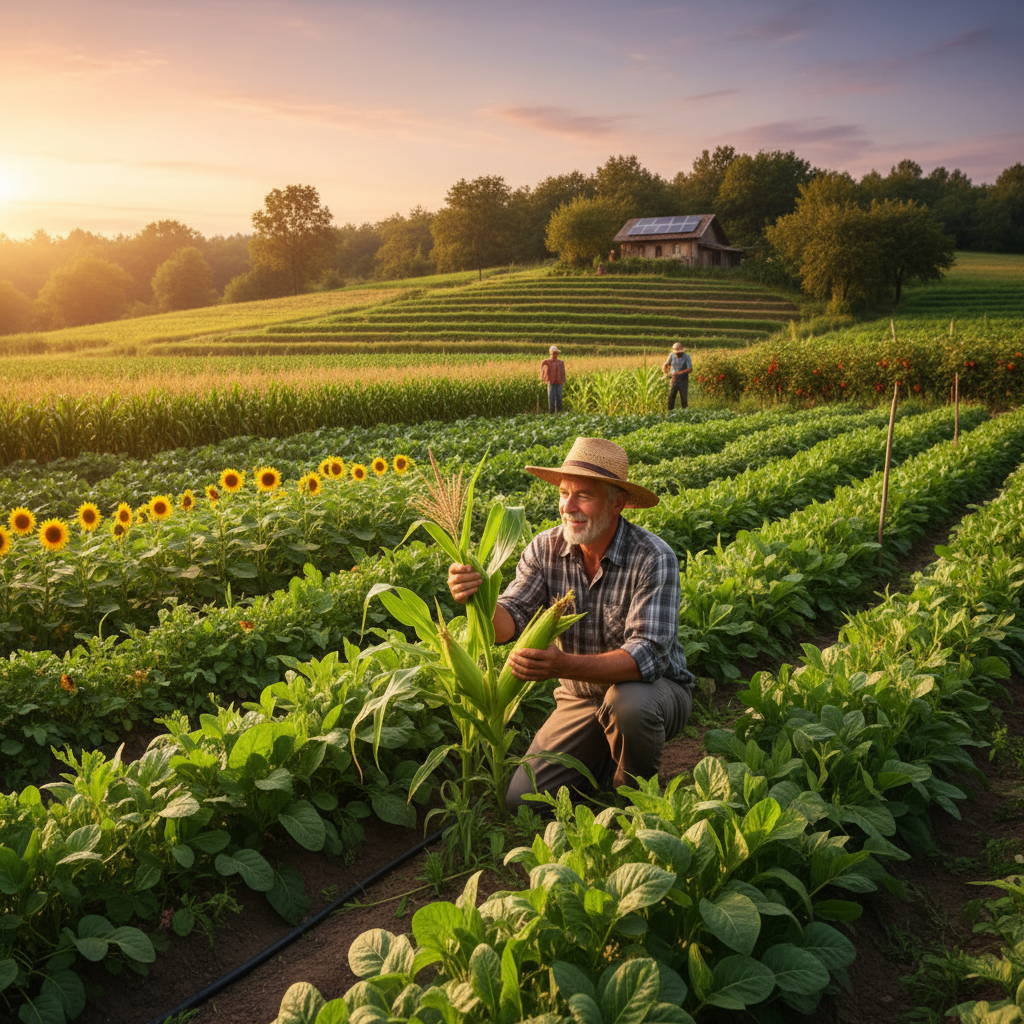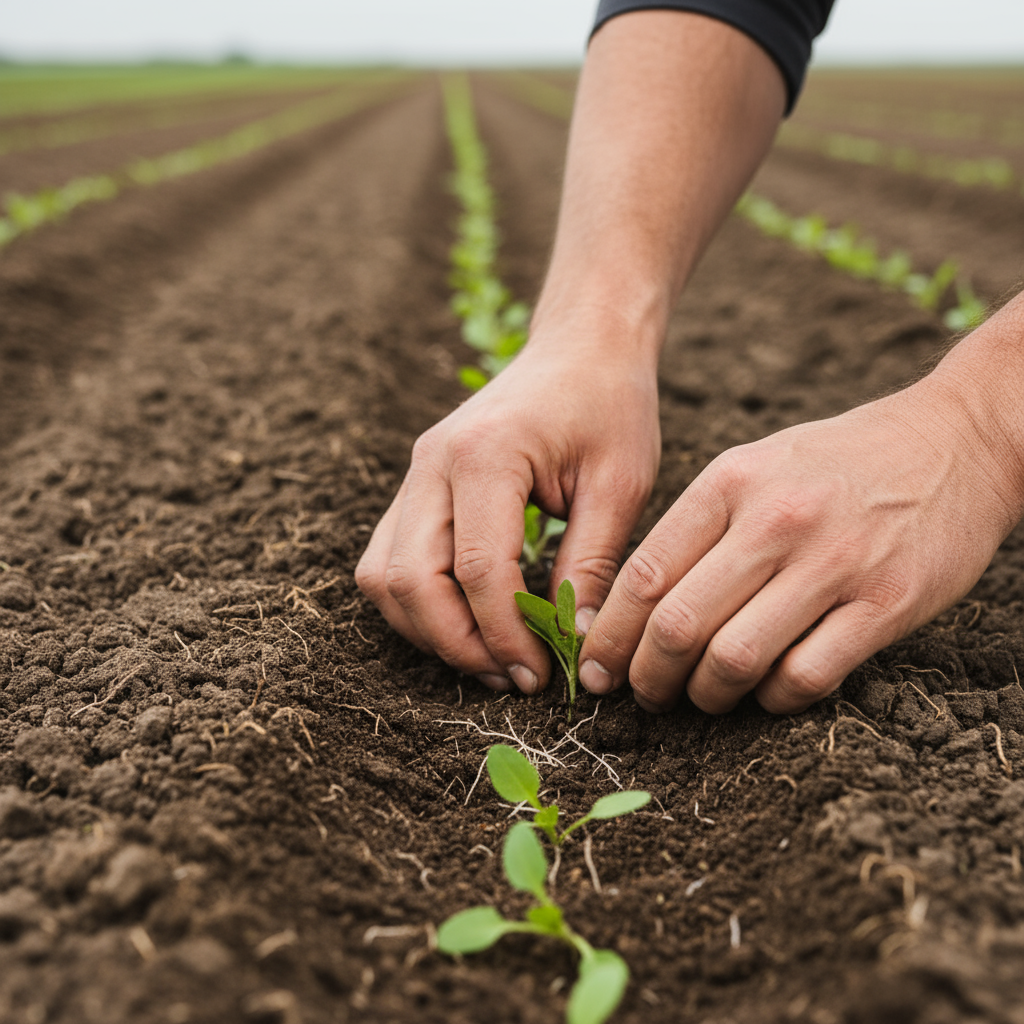
Table of Contents
Introduction
Here’s something that might surprise you: farming doesn’t have to be a battle against nature. In fact, the most successful farms work with the environment, not against it. With our planet’s population growing and climate change throwing curveballs at farmers everywhere, sustainable agriculture isn’t just nice to have—it’s becoming essential. Think of it as farming that actually makes sense for the long haul, where feeding people today doesn’t mean starving future generations.
The thing about traditional farming is that it’s often focused on quick wins. Pump the soil full of chemicals, get bigger yields this season, worry about tomorrow later. But here’s the problem: tomorrow always comes. And when it does, the soil is depleted, water sources are contaminated, and beneficial insects have disappeared. Sustainable farming flips this script entirely. It’s about nurturing the soil, conserving water, and letting nature handle pest control (she’s surprisingly good at it). If you’ve ever looked into sustainability in practices like the fashion industry, you’ll recognize the same core principle: make things in a way that doesn’t destroy the very resources you depend on.
Water is where things get really interesting. Remember the last time you dealt with an unexpected drought or flooding? Farmers face these challenges constantly, and traditional methods often make things worse. Smart water management—like rain gardens, contour farming, and efficient irrigation—can be game-changers. Take rain gardens, for example. Learning how to build a rain garden shows you how brilliant natural systems can be at managing water runoff while recharging groundwater. It’s like giving your landscape a built-in insurance policy against extreme weather.
But here’s where it gets even better: sustainable agriculture doesn’t stop at the farm gate. Ever thrown away wilted lettuce or moldy bread? (We all have.) That waste connects directly to farming sustainability. When we reduce food waste and create circular systems—think composting kitchen scraps that eventually feed the soil—we’re completing the loop. Those practical food waste reduction tips you might use at home? They’re part of the same philosophy that drives sustainable farming: use what you have wisely, waste nothing, and keep the cycle going.
What You’ll Learn in This Guide
Ready to dig deeper? This guide breaks down everything you need to know about sustainable agriculture, whether you’re curious about farming, passionate about the environment, or just want to understand where your food really comes from.
- Core Principles of Sustainable Agriculture: We’ll explore how environmental care, economic sense, and social responsibility work together to create farming that actually sustains itself—and us.
- Key Sustainable Techniques: You’ll discover methods like crop rotation, cover cropping, integrated pest management, agroforestry, and conservation tillage that keep soil healthy and ecosystems thriving.
- Benefits of Sustainable Practices: Learn why these approaches create more biodiversity, better food security, and stronger farming communities.
- Overcoming Challenges: We’ll tackle the real obstacles farmers face and share practical strategies for making the transition to sustainable methods work.
What you’ll find in the coming sections isn’t just theory—it’s actionable information you can use. And yes, we’ll tell you when it’s time to call in the experts, because some things are worth getting professional help with. Sustainable agriculture is a learning process, and this guide gives you the foundation to either start your own journey or support others who are already on theirs.
You might notice themes that pop up in other sustainability movements too. The same principles driving sustainability in the fashion industry—reducing environmental impact, using resources responsibly, thinking long-term—show up everywhere people are trying to build better systems. It’s all connected.
So why should you care about this? Whether you’re dreaming of starting a small farm, working on environmental projects, or simply want to make better choices about the food you buy, sustainable agriculture offers real solutions. Not pie-in-the-sky promises, but practical approaches that are already working for farmers around the world. Let’s explore how these techniques can nurture both the soil and the communities that depend on it.

Sustainable agriculture is having a moment—and for good reason. But here’s the thing: understanding the ‘why’ behind sustainable farming isn’t enough anymore. You need to know the ‘how.’ What are the actual principles that make farming truly sustainable? Which techniques actually work in the real world? That’s exactly what we’re going to explore together. Think of this as your practical guide to the methods that are transforming agriculture from the ground up (literally). Whether you’re a farmer looking to make changes, a policy maker crafting regulations, or someone who simply cares about where their food comes from, these insights will help you understand how sustainable agriculture creates wins for the environment, the economy, and entire communities.
Core Principles of Sustainable Agriculture
Let’s get straight to the heart of it. Sustainable agriculture isn’t just about using fewer chemicals or being “nice to the environment.” It’s built on three rock-solid pillars that work together like a three-legged stool—remove any one, and the whole thing topples over. These pillars? Environmental Stewardship, Economic Viability, and Social Responsibility. And here’s what makes this approach so powerful: when you strengthen one pillar, you automatically support the others. It’s like a positive feedback loop that keeps getting better.
Why does this matter so much? Because sustainable agriculture represents a complete shift in how we think about farming. It’s not just about protecting natural resources (though that’s crucial). It’s not just about keeping farms profitable (though farmers need to eat too). And it’s not just about fair labor practices (though every worker deserves dignity). It’s about recognizing that all these elements are connected. When you take care of the soil, you often reduce costs. When you treat workers fairly, you get better productivity. When you protect biodiversity, you build natural pest control. See how it all fits together? If you’re curious about how these sustainability principles apply across different industries, check out our exploration of sustainability efforts in related industries for some interesting parallels.
Key Aspects of Core Principles
Now, let’s break down what each of these principles actually looks like in practice. Because knowing the theory is one thing—seeing how it works on real farms is another.
- Environmental Stewardship: This is about being a good neighbor to nature. Think soil health, water conservation, and creating habitats that support wildlife. The goal? Farm in a way that leaves the land better than you found it. This means cutting back on chemicals when possible and working with natural systems instead of against them.
- Economic Viability: Here’s the reality check—if farming doesn’t pay the bills, it’s not sustainable. Period. This principle focuses on smart cost management, finding multiple income streams, and connecting with markets that value what you’re doing. Strong local economies help too, creating networks of support and knowledge sharing.
- Social Responsibility: Farming doesn’t happen in a vacuum. It involves real people working real jobs in real communities. Fair wages, safe working conditions, and making sure the benefits of agriculture reach everyone—not just farm owners. When communities thrive, farms thrive too.
- Integration of Practices: This is where the magic happens. Instead of treating these principles as separate boxes to check, successful sustainable farms weave them together. It’s about continuous learning, adapting to new challenges, and building partnerships between farmers, researchers, and communities.
When farmers really embrace these principles, something interesting happens. They stop seeing trade-offs everywhere and start spotting opportunities. Better soil health leads to lower input costs. Diverse crops create more stable income. Happy workers are productive workers. It’s not always easy, but it’s definitely worth it. And that brings us to the practical side—the actual techniques that make these principles come alive on working farms.
Key Sustainable Agriculture Techniques
Alright, let’s talk technique. This is where sustainable agriculture gets really interesting because you’re taking those big principles and turning them into everyday farming practices. Each technique serves multiple purposes—maybe it improves soil health while cutting costs, or boosts biodiversity while managing pests naturally. The beauty is in how these methods work together, creating farming systems that just keep getting stronger over time.
What’s exciting is how these techniques adapt to different situations. A small organic farm in Vermont might use crop rotation differently than a large operation in Iowa, but the underlying principles remain the same. And the innovation happening in this space? It’s incredible. Farmers are combining traditional wisdom with cutting-edge research to develop methods that seemed impossible just a decade ago. Speaking of innovation across industries, you might find it interesting how similar thinking is being applied to greenhouse gas emission reduction strategies in other sectors—it’s all part of the same sustainability movement.
Essential Techniques in Sustainable Farming
These are the heavy hitters—the techniques that form the backbone of most sustainable farming operations. Each one brings something unique to the table.
- Crop Rotation: Think of this as giving your soil a varied diet. Instead of growing the same crop year after year (which is like eating only pizza—fun at first, but not great long-term), you rotate different crops through the same fields. Different plants need different nutrients and attract different pests, so rotation naturally balances things out while reducing the need for fertilizers and pesticides.
- Cover Cropping: This is essentially putting a blanket on your soil during the off-season, but way more useful. Cover crops protect against erosion, trap moisture, and when they decompose, they add organic matter back to the soil. Legume cover crops even pull nitrogen from the air and store it in the soil—free fertilizer!
- Integrated Pest Management (IPM): Instead of reaching for the chemical spray gun every time you see a bug, IPM asks, “What’s the smartest way to handle this?” Maybe it’s encouraging beneficial insects, maybe it’s changing planting timing, maybe it’s a targeted treatment. The goal is to work with nature’s pest control systems whenever possible.
- Agroforestry: Picture this: productive farmland with trees strategically placed throughout. Those trees aren’t just pretty—they’re creating microclimates, preventing soil erosion, providing habitat for beneficial wildlife, and often producing additional income through fruits, nuts, or timber. It’s farming in three dimensions instead of two.
What makes these techniques so powerful isn’t just what they do individually—it’s how they work together. Crop rotation supports IPM by breaking pest cycles. Cover crops complement agroforestry by building soil health. Everything connects. The farmers who master this approach don’t just grow food; they build resilient systems that can handle whatever challenges come their way, from climate extremes to market shifts. And that resilience? That’s what truly sustainable agriculture is all about.

Sustainable agriculture isn’t just another farming trend—it’s a complete rethinking of how we grow food. At its heart, it’s about finding that sweet spot where environmental health, economic sense, and social responsibility all come together. Think of it like a three-legged stool: take away any one of these elements, and the whole thing wobbles. The techniques we’ve covered—crop rotation, cover cropping, integrated pest management, agroforestry, and conservation tillage—they’re all pieces of this bigger puzzle. When farmers use these methods thoughtfully, something amazing happens: the land gets healthier while still producing the food we need. It’s like giving your soil a multivitamin while asking it to do its job better.
Now, here’s where it gets really interesting. The benefits of sustainable farming don’t just stay on the farm—they ripple outward like stones thrown into a pond. Biodiversity thrives when we cut back on harsh chemicals. Natural resources stay protected for the long haul (and trust me, we’re going to need them). Economically? Well, healthier soil means lower input costs over time, and that’s money back in farmers’ pockets. Plus, there’s the social side: fair wages, stronger communities, and food systems that actually make sense. But let’s be real—it’s not all sunshine and rainbows. The upfront costs can be steep, and there’s definitely a learning curve. Some farmers hit roadblocks with market access or just don’t know where to start. That’s where collaboration and sometimes expert guidance become game-changers.
So what’s next? If you’re feeling inspired to dig deeper into sustainability (pun intended), there are some fascinating connections to explore. Take the fashion industry, for example—it’s grappling with many of the same challenges around environmental impact and ethical production. Or maybe you want to get your hands dirty closer to home? Building a rain garden is an incredible way to manage water sustainably while creating habitat for local wildlife. And if you’re looking to bring people together, starting a community garden hits all the right notes: local food, green spaces, and stronger neighborhood connections. You can explore these ideas further through our detailed guide on sustainability in the fashion industry and get practical with how to build a rain garden or starting a community garden.
Here’s the bottom line: sustainable agriculture gives us a chance to completely reimagine our relationship with food, land, and each other. Sure, the road isn’t always smooth—change rarely is. But when you step back and look at the bigger picture? The benefits make every challenge worth tackling. Whether you’re a farmer, a gardener, or just someone who cares about where your food comes from, you have a role to play. Stay curious, take action where you can, and remember that every small step adds up. We’re building something here—a food system that works with nature instead of against it. And that’s a legacy worth leaving for the next generation.
Frequently Asked Questions
-
What is sustainable agriculture?
- A farming approach that balances environmental health, economic profitability, and social equity.
-
How does crop rotation benefit the soil?
- It helps maintain soil fertility and reduce pest buildup.
-
Can sustainable agriculture techniques increase crop yield?
- Yes, by improving soil health and pest management, yields can improve over time.
-
What challenges do farmers face when adopting these techniques?
- Issues such as initial costs, knowledge gaps, and market access are common.
-
Where can farmers find support for sustainable farming?
- Local agricultural extension services and sustainability organizations offer resources and guidance.
